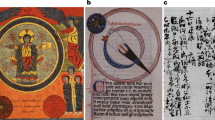Summary
Ice nuclei counts made twice daily at Mauna Loa Observatory, Hawaii, throughout the Kilauea Iki and Puna eruptions of November 1959 to February 1960 did not show the increases reported elsewhere during periods of volcanic activity and were apparently not, affected by the visible presence of the volcanic effluent, even on days when this could be presumed to include enormous numbers of salt particles produced along the contact zone between hot lava flows and the sea. The observations suggest that not all active volcanos act as important sources of atmospheric ice nuclei, but that, in fact, other substances concurrently released may even inhibit nucleation.
Zusammenfassung
Während der Eruptionen des Kilauea Iki und des Puna von November 1959 bis Februar 1960 wurden am Mauna-Loa-Observatorium (Hawaii) täglich zweimal Zählungen der Eiskerne mit Hilfe einer Expansionskammer vorgenommen. Im Gegensatz zu den Beobachtungen an anderen Orten bei Vulkanausbrüchen konnte im vorliegenden Fall kein Anstieg der Eiskernzahlen festgestellt werden, obwohl der vulkanische Staub sichtbar war. Selbst an Tagen, an welchen von der Kontaktfläche zwischen Lavastrom und Meer große Mengen von Salzpartikeln in die Atmosphäre gelangt sein müssen, wurde kein Anstieg beobachtet. Die vorliegenden Ergebnisse deuten darauf hin, daß nicht alle aktiven Vulkane wesentliche Quellen von Eiskernen sind und daß möglicherweise andere Stoffe, die gleichzeitig ausgestoßen werden, die Eisbildung sogar hindern können.
Résumé
A l'observatoire de Mauna Loa (Hawaï), on a dénombré les noyaux de congélation deux fois par jour au moyen d'une chambre d'expansion; ces mesures ont été effectuées de novembre 1959 à février 1960, c'est à dire durant la période d'éruption du Kilauea Iki et du Puna. Au contraire d'observations faites ailleurs lors d'éruptions volcaniques, il ne fut pas possible de déterminer ici une augmentation du nombre des noyaux de congélation bien que la poussière volcanique ait été visible à l'oeil nu. On n'a même pas constaté d'augmentation au cours des journées où le courant de lave entrait en contact avec la mer, c'est a dire durant les périodes où de grandes quantités de particules de sel étaient entraînées dans l'atmosphère. Ces résultats montrent que tous les volcans actifs ne doivent pas nécessairement être source de noyaux de congélation et qu'il est en outre possible que certaines substances émises en même temps que la poussière volcanique empêchent même la formation de glace.
Similar content being viewed by others
References
Bigg, E. K., andR. T. Meade: Continuous Automatic Recording of Ice Nuclei. Bull. Obs. Puy de Dôme no.4, 125–138 (1959).
Birstein, S. J.: Studies on the Effect of Chemisorbed Impurities on Heterogeneous Nucleation. Monograph No. 5, Amer. Geophys. Un., 247–250 (1960).
Bowen, E. G.: An Unorthodox View of the Weather. Nature177 1121–1123 (1956).
Bowen, E. G.: A Relation between Meteor Showers and the Rainfall of November and December. Tellus8, 394–402 (1956).
Bowen, E. G.: January Freezing Nucleus Measurements. Austral. J. Phys.9, 552–555 (1956).
Brier, G. W., andD. B. Kline: Ocean Water as a Source of Ice Nuclei. Science130, 717–718 (1959).
Eaton, J. P., andK. J. Murata: How Volcanoes Grow. Science132, 925–938 (1960).
Fox, R. L.: New Mauna Loa Observatory Unit. Nature178, 1272 (1956).
Georgii, H. W.: Discussion, of a paper byD. B. Kline, Recent Observations of Freezing Nuclei Variations at Ground Level. Monograph No. 5, Amer. Geophys. Un., 245 (1960).
Kline, D. B., andG. W. Brier: A Note on Freezing Nuclei Anomalies. Monthly Weather Rev.86, 329–332 (1958).
Kline, D. B., andG. W. Brier: Some Experiments on the Measurement of Natural Ice Nuclei. Monthly Weather Rev.89, 263–272 (1961).
Isono, K., andM. Komabayashi: The Influence of Volcanic Dust on Rainfall. Coll. Met. Papers (Japan)5, 345–353 (1954).
Isono, K., M. Komabayashi andA. Ono: Volcanoes as a Source of Atmospheric Ice Nuclei. Nature183, 317–318 (1959).
Price, S., andJ. C. Pales: The Mauna Loa High Altitude Observatory. Monthly Weather Rev.87, 1–14 (1959).
Warner, J.: An Instrument for the Measurement of Freezing Nuclei Concentrations. Bull. Obs. Puy de Dôme no. 2, 33–46 (1957).
Woodcock, A. H.: Lava and the Sea. OceanusVI, no. 3, 12–13 (1960).
Woodcock, A. H., andA. T. Spencer: Lava—Sea—Air Contact Areas as Sources of Sea-Salt Particles in the Atmosphere. J. Geophys. Res.66, 2873–2887 (1961).
Author information
Authors and Affiliations
Additional information
With 2 Figures
Rights and permissions
About this article
Cite this article
Price, S., Pales, J.C. Local volcanic activity and ice nuclei concentrations on Hawaii. Arch. Met. Geoph. Biokl. A. 13, 398–407 (1963). https://doi.org/10.1007/BF02248000
Published:
Issue Date:
DOI: https://doi.org/10.1007/BF02248000




